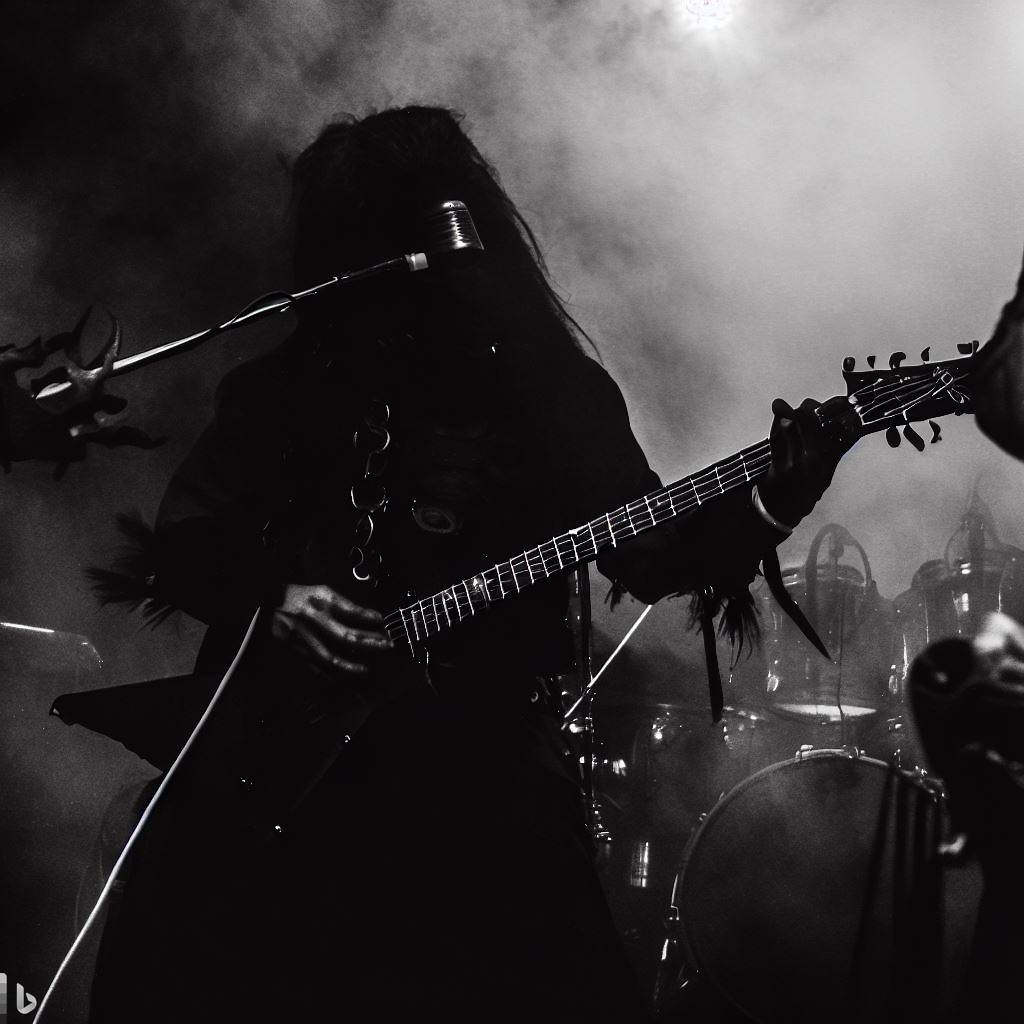
What Is Black Metal Music – Exploring the Dark Genre
Black metal music: a genre that stirs curiosity, confusion, and sometimes even fear. What’s lurking behind those thunderous drums and screeching guitars? Is it merely noise, or is there a profound artistry hidden within the chaos?
Think of a dark, stormy night where the lightning’s flash reveals glimpses of a mysterious landscape. That’s black metal, a musical storm that’s both terrifying and fascinating.
With roots in rebellion and a desire to break free from conventional musical norms, black metal has become a symbol of individuality and defiance.
In this article, we’ll explore the intricate layers of this genre, unraveling its complexity through real-world examples and analogies. Ready to dive into the abyss of black metal?
Join us, and let’s uncover the secrets of a musical world that’s as enigmatic as it is enthralling.
Introduction to Black Metal Music
Black metal music is more than just a genre; it’s an experience, a journey into a world of intensity and darkness. But what exactly is black metal, and how did it evolve into the captivating genre we know today?
The Origins and Evolution of Black Metal
Black metal’s origins can be traced back to the early 1980s, where it emerged as a subgenre of heavy metal. It was a time when bands were pushing boundaries, exploring new sounds, and challenging conventional musical norms.
- The Birth of Black Metal: Bands like Venom and Bathory were pioneers, releasing albums that would become the blueprint for black metal. Their raw sound, characterized by screeching vocals and distorted guitars, laid the foundation for a genre that would evolve and diversify.
- Norwegian Influence: The 1990s saw the rise of Norwegian bands like Mayhem, Darkthrone, and Immortal. They embraced satanic themes, Norse mythology, and a unique sound that set them apart. Ever wondered what it would be like to have a subwoofer for metal music? The thunderous drums and intense basslines of these bands would give you a taste of that experience.
- Evolution and Diversity: From atmospheric to melodic black metal, the genre has continued to evolve. Bands like Behemoth and Belphegor have pushed the boundaries, experimenting with different sounds and themes.
Isn’t it fascinating how a genre that started with a few underground bands has grown into a global phenomenon? The evolution of black metal is a testament to the creativity and resilience of the artists who dared to explore the unknown.
The Unyielding Spirit and Allure of Black Metal
The allure of black metal goes beyond its sound. It’s about the emotions it evokes, the stories it tells, and the world it transports you to.
- Embracing the Darkness: Black metal is not for the faint of heart. It’s a genre that embraces darkness, rebellion, and intensity. But why does it captivate so many? Perhaps it’s the freedom to explore emotions and themes that are often considered taboo.
- Controversy and Resilience: From church burnings to tragic events, black metal has faced its share of controversies. Yet, it has emerged stronger, with bands continuing to create and fans continuing to support.
- The Unyielding Spirit: Black metal’s enduring popularity is a testament to its unyielding spirit. It’s a genre that refuses to conform, that challenges the status quo, and that continues to inspire and captivate.
The Roots of Black Metal Music: A Historical Perspective
From Death Metal to Black Metal: The Birth of a Genre
The transformation from death metal to black metal is akin to a metamorphosis, where the raw energy of one genre gave birth to something entirely new and distinct. But how did this transformation occur?
- The Birth of a Genre: In the early 1980s, bands like Venom and Bathory began to experiment with a sound that was rawer and more intense than traditional heavy metal. This was the beginning of black metal, a genre that would soon carve its own unique identity.
- Distinguishing Features: Unlike death metal, black metal focused on atmospheric elements, high-pitched shrieking vocals, and tremolo-picked guitars. Imagine the eerie sound of wind howling through a desolate landscape; that’s the essence of black metal’s sound.
- A Break from Convention: Black metal was not just a musical style; it was a rebellion against the conventional norms of metal music. It was a genre that dared to be different, to challenge, and to provoke.
What was it about black metal that set it apart from its predecessors? It was a genre unafraid to explore the unknown, to venture into the abyss, and to create something profoundly unique.
Iconic Albums and Bands that Shaped Black Metal
The history of black metal is marked by iconic albums and bands that not only shaped the genre but also left an indelible mark on the world of heavy metal.
- Venom’s “Black Metal”: Released in 1982, this album is considered a seminal work that gave the genre its name. It was a declaration of a new era in metal music.
- Bathory’s Self-Titled Debut: Bathory’s 1984 debut album laid the groundwork for the atmospheric and thematic elements that would become synonymous with black metal.
- Mayhem’s “Deathcrush”: A 1987 release that became a symbol of black metal’s controversial and sometimes violent aspects.
- The Legacy of Bands: Bands like Immortal, Darkthrone, and Burzum played pivotal roles in shaping the genre, each contributing unique elements that defined black metal.
How did these albums and bands shape a genre? Through innovation, experimentation, and a relentless pursuit of artistic expression. They were the architects of a musical movement that continues to resonate today.
The Norwegian Influence in Black Metal Music
Norway, a land of fjords and northern lights, became an unlikely epicenter for black metal’s evolution. But what was it about Norway that made it such fertile ground for black metal?
- The Rise of Norwegian Bands: Bands like Immortal, Darkthrone, Burzum, and Emperor became torchbearers for black metal, infusing the genre with themes of Satanism, Norse mythology, and a raw, unfiltered sound.
- Church Burnings and Controversy: The early 1990s saw a series of church burnings in Norway, a defining and controversial moment in black metal’s history.
- A Cultural Movement: Black metal in Norway was not just music; it was a cultural movement that challenged societal norms and religious beliefs.
- The Global Impact: The Norwegian black metal scene influenced bands worldwide, shaping the global landscape of black metal music.
Certainly! Here’s another take on the section focusing on the controversies and dark moments in black metal history:
Controversies and Dark Moments in Black Metal History
The Infamous Church Burnings and Their Impact
The church burnings in Norway’s black metal scene during the early 1990s are a stark reminder of how art and action can intertwine. But what led to these acts, and what do they signify?
- A Symbolic Act: The church burnings were more than mere destruction; they symbolized a rejection of Christianity and societal norms. Imagine a painting that uses bold strokes and dark colors to express anger and defiance; that’s what these acts represented in real life.
- The Musicians’ Involvement: Key figures in the black metal scene were directly linked to these acts, raising questions about the responsibility of artists. Should music be blamed, or were these individual choices?
- Media Reaction and Public Perception: These events became a media sensation, leading to a backlash against black metal. Was the entire genre unfairly demonized?
- A Complex Legacy: The church burnings left a lasting impact on black metal, influencing its perception and sparking debates about art, ethics, and individuality.
How do we navigate the complex relationship between art and action? It’s a question that invites us to explore the essence of expression, rebellion, and the human condition.
Tragic Events and Notorious Figures in Black Metal
The black metal scene has also been marked by tragic events and notorious figures that have both fascinated and appalled the public. What do these events reveal about the genre?
- The Murder of Euronymous: The shocking murder of Mayhem’s guitarist Euronymous by Varg Vikernes exposed a violent undercurrent in the black metal scene. It’s like a dark twist in a novel that changes everything you thought you knew.
- Suicides and Other Tragedies: Suicides and acts of violence have added to black metal’s mystique. Are these reflections of the intense emotions in the music, or something more complex?
- Notorious Figures and Their Impact: Individuals like Varg Vikernes have become symbols of black metal’s controversial side. How do these figures shape our understanding of the genre?
- A Multifaceted Narrative: These events are part of a complex story that challenges stereotypes and invites a deeper understanding of black metal.
What can we learn from these dark moments? They uncover a genre that’s unafraid to confront life’s complexities, a genre that challenges us to think, question, and perhaps even understand the human soul’s darker corners.
Subgenres and Musical Exploration within Black Metal
The Evolution of Black Metal into Subgenres
Black metal, like a tree with many branches, has grown and diversified into various subgenres. But how did this evolution occur, and what are the key subgenres that have emerged?
- Atmospheric Black Metal: This subgenre focuses on creating a dense and ethereal atmosphere. Imagine standing on a fog-shrouded mountain; that’s the feeling atmospheric black metal aims to evoke.
- Symphonic Black Metal: By incorporating orchestral elements, symphonic black metal adds a grand and theatrical dimension to the music. Think of it as a dark and twisted symphony.
- Depressive Black Metal: This subgenre explores themes of despair, sorrow, and isolation. It’s like a haunting poem set to music.
- Blackened Death Metal: A fusion of black metal with death metal, this subgenre combines the raw intensity of black metal with the brutal heaviness of death metal.
- Folk Black Metal: By integrating folk instruments and themes, this subgenre creates a unique blend that connects with cultural and historical roots.
What do these subgenres tell us about black metal? They reveal a genre that’s constantly evolving, experimenting, and pushing musical boundaries.
Fusion and Experimentation in Black Metal Music
Black metal’s willingness to experiment and fuse with other musical styles has led to a rich and diverse musical landscape. But what drives this fusion, and how has it shaped the genre?
- Experimentation with Jazz and Progressive Elements: Some black metal bands have experimented with jazz and progressive rock elements, creating a complex and intricate sound. It’s like mixing colors on a palette to create a new shade.
- Incorporation of Electronic and Industrial Sounds: By incorporating electronic and industrial sounds, black metal has ventured into new sonic territories. Imagine the cold, mechanical precision of a machine blended with the raw emotion of black metal.
- Cultural Fusion: Some bands have fused black metal with local musical traditions, creating a unique blend that reflects their cultural identity.
- A Platform for Innovation: Black metal has become a platform for musical innovation, where artists are free to explore, experiment, and create without boundaries.







